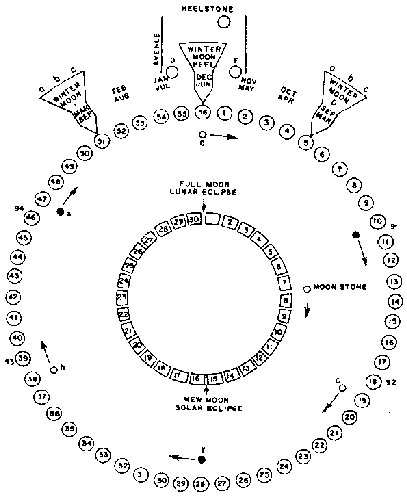 |
Science Frontiers ONLINE No. 106: Jul-Aug 1996 |
|
|
Stonehenge in the 1990s: a mainstream view
In a recent number of Nature, C. Ruggles reviewed the present status of Stonehenge as mainstream archeologists now see this world-famous monument.
oThe construction of Stonehenge began a bit earlier than previously thought: 2950 � 50 BC. But beneath the present parking area are post holes dated 4,000 years earlier! They are apparently not related to the Stonehenge we know.
oThe idea that Stonehenge's bluestones, which originated in the Preseli Mountains of southwest Wales, 200 kilometers distant, were carried to Salisbury Plain by glaciers has been emphatically disproved by geologists. These 4-ton stones were transported by people! This great effort required precocious social organization, communication, and some kind of psychological impetus.
oThe sarsens -- those even bigger stones that define Stonehenge in our mind's view -- evoke the same sorts of questions as this issue's eccentric flints: Why? and How? Ruggles writes:
"Why it was important to bring stones from so far away is an open question, as is the issue of how people achieved the almost unimaginable feat of hauling the sarsens, weighing 25 tonnes or more, over 30 km from the Marlborough Downs in the north."
oNew studies of the other ancient monuments in the vicinity of Stonehenge have revealed that they were not placed at random. Many are visible from Stonehenge. Stonehenge is at the center of a number of "nested bowls." [?] Further, barrows of the Early Bronze Age were placed in lines along the horizon ridges visible from Stonehenge. There was obvious regional planning -- a master plan that we have not yet deciphered.
oIt is now generally accepted that astronomical alignments do exist at Stonehenge, and that the monument itself and the surrounding sites are somehow related to astronomical time cycles. However, mainstream opinion has not been kind to the 1960's vision of Stonehenge as a Neolithic computer and/or astronomical observatory. This idea is now seen as: "...an artefact of its times -- one of the most notorious examples known to archaeologists of an age recreating the past in its own image."
(Ruggles, Clive; "Stonehenge for the 1990s," Nature, 381:278, 1996)
Comment. If Stonehenge is not a 1960's cyber-vision, just what did the Stonehengers have in mind? Did the even more-ancient people who dug those post holes now under a parking lot feel a similar psychological impulse?
 |
In the 1960s, some viewed Stonehenge as an astronomical computer of sorts, as in this conceptualization by G. S. Hawkins. This idea is still popular. |